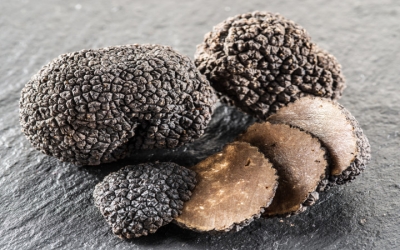
Truffles are an expensive food delicacy used in the very best French pates. They look like large spongy walnuts and grow in the ground. Because they like to eat them, pigs are often used to find truffles.
The most-valued truffle in French cuisine is the Perigord (Tuber melanosporum), which is said to have first gained favour toward the end of the 15th century. It is brown or black, rounded, and covered with polygonal wartlike protrusions, having a depression at their summit; the flesh (gleba) is first white, then brown or gray, and when mature becomes black with white veins having a brown margin. The odour is well marked and pleasant. The main French truffieres (truffle grounds) are in the south, notably in Perigord and the region of Provence–Alpes–Cote d’Azur, though truffles are gathered throughout a large part of France.
The truffle industry is an important one in France, and about one-third of the gatherings are exported. The French government undertook the reforesting of many large and barren areas, for many of the best truffle regions become productive by the planting of trees, particularly oaks. Because truffles often occur at depths down to about 30 centimetres (12 inches), it is difficult to detect them unaided. Truffles, when occurring near the surface of the ground, crack it as they reach full size, and experienced gatherers can detect them. Furthermore, in the morning and evening, columns of small yellow flies may be seen hovering over a colony. Occasionally an individual is sufficiently sensitive to the scent of truffles to locate them, but truffle hunting is usually carried on with the aid of trained dogs or female pigs (which are attracted by the truffle’s scent, similar to that of male pig pheromones).
Although truffles are much desired as food, direct cultivation of truffles for commerce is difficult. Calcareous ground is dug over and acorns or seedlings planted. Soil from truffle areas is usually spread about, and the ground is kept in condition by light plowing and harrowing. After three years, clearings are made and the trees pruned. If they are to appear, truffles do so only after about five years; gathering begins then but is not very profitable until 8 or 10 years have passed. The yield is at its maximum from 5 to 25 years later.
Credit : Britannica
Picture Credit : Google




